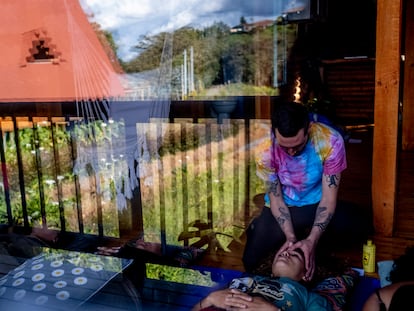LSD: The bike ride that changed the course of cultural history
The discovery of this hallucinogen was a fluke, and it started a journey in which science, the CIA, music and medicine all played a role

In mid-August 1951, hundreds of respectable citizens went mad in Pont-Saint-Esprit, a small town in the south of France, on the right bank of the Rhône, where Provençal legends place the dragon’s lair and into whose waters some of the disturbed people threw themselves, jumping from the windows of their homes amidst perturbing screams and hallucinated despair.
The death toll was seven, while more than 300 residents were traumatized and suffered long-term effects. The cause was a parasitic fungus of the genus Claviceps called ergot, “very abundant in Europe and, above all, in the Mediterranean basin,” as Antonio Escohotado points out in his General History of Drugs.
Once in contact with grain, the parasite produces metabolites called ergot alkaloids, i.e. mycotoxins that usually affect cereals such as rye, corn, millet and oats, and whose ingestion causes alterations in consciousness. It is curious that the effects are felt once the substance has disappeared from the central nervous system, remaining lodged in the spleen, liver and kidneys, with the bloodstream carrying it around the body.
A few years before the Pont-Saint-Esprit incident, Dr. Albert Hofmann had discovered LSD. As history would have it, the discovery was serendipitous, since Hofmann was looking for an analeptic, a cardiocirculatory stimulant, and to do so, he synthesized ergot. This happened on November 16, 1938. After testing it on animals, it did not work as expected, and the sample was left gathering dust on a shelf.
Years later, Dr. Hofmann’s fingertips touched the substance and absorbed a small dose—enough for him to perceive a state of consciousness “very strange that today we would call psychedelic,” in his own words. Continuing to study the substance, three days later Hofmann conducted the first planned experiment with LSD. It was April 19, 1943. The details have been told many times; Hofmann overdosed, suffered a panic attack, and asked his assistant to accompany him home. They made the trip by bicycle due to the fuel shortage brought on by World War II. Just as the movement of a door can change the course of the present, that bicycle trip changed the course of the history of Western culture. But let’s take it one step at a time, or rather, one moment at a time.
Because, at first, LSD was a substance used by the CIA for war purposes. The link was Dr. Max Rinkel, who managed to introduce the first supply of LSD into the United States. It was in 1949 and the CIA financed its acquisition from the Swiss pharmaceutical company Sandoz. From then on, experiments followed one after another, reaching levels of true madness. Poisoning Moscow’s water tanks with LSD during the Cold War or using it in interrogations as a truth serum were just some of the possibilities that were considered in view of the drug’s potential. To do this, experiments were carried out on involuntary people, violating the Nuremberg code for medical ethics. The case of Dr. Frank Olson is an example. Olson was an Army scientist who was used as a guinea pig by the CIA in November 1953. They put LSD in his drink and he could not bear the trip. It ended with him crashing into the wet pavement of a New York sidewalk in the early hours of the morning: without any warning, Frank Olson threw himself from one of the windows of the Statler Hilton.
Acid trips were already becoming part of the occupational hazards of CIA agents as well as army personnel specializing in biological warfare. Madness and death were combined with suspicion in those hectic days when paranoia coexisted with insanity. The American journalists Martin A. Lee and Bruce Shlain explained it in 1986 in Acid Dreams, a cult book that constitutes a deep dive into the subject; the definitive chronicle that goes beyond the scientific dimension to reach the field of social history in an era dominated by lysergic acid, at a time when protest groups were springing into action, uniting militancy and entertainment, and giving extra work to the CIA, whose agents infiltrated like lice in the hair of a youth eager to change the world.
“We want the world and we want it now,” sang Jim Morrison as the frontman for The Doors, one of the most significant bands on the California scene and whose name is taken from the title of Aldous Huxley’s essay The Doors of Perception, which in turn has its origins in a quote from William Blake, the visionary poet who wrote in 1793: “If the doors of perception were cleansed every thing would appear to man as it is, Infinite.”
And so we come to the final moment, when the germ of destruction contained within the dynamics of the story gets ahead of the CIA sabotage and Charles Manson spills blood on the acid dream, to which we must add the events of December 6, 1969, when the Rolling Stones were performing on the Altamont stage and a young man was stabbed to death by one of the Hell’s Angels. It was the end of the psychedelic dream and the final touch was administered by the Beatles a few months later, in April 1970, when they announced their separation with a significantly named testament: Let It Be. It must be remembered that three years earlier they had published their lysergic trip: Sgt. Pepper’s.
However, disconnection from reality through psychoactive drugs continued to have its appeal [...] because the distorted perception of time and the images contained in space, as well as the alteration of the senses, is nothing new. Today, the clinical potential of these hallucinogenic properties has been tested again in patients with depression.
In the end, chance is the closest thing to an algebraic formula whose interpretation determines the order of the unforeseen. That is why chance and bad or good fortune manage to meet at the end of the path, like two parallel lines that cross in infinity. Thus, high temperatures turn humid places into favorable environments for filamentous fungi to sprout on cereals and produce mycotoxins and alkaloids. The reddish dust resulting from grinding the cereal will be hidden in the cursed flour, so that nobody will connect their madness with the consumption of dark bread, as happened in Pont-Saint-Esprit, a town in France where its inhabitants involuntarily found out about the attraction of death.
Sign up for our weekly newsletter to get more English-language news coverage from EL PAÍS USA Edition
Tu suscripción se está usando en otro dispositivo
¿Quieres añadir otro usuario a tu suscripción?
Si continúas leyendo en este dispositivo, no se podrá leer en el otro.
FlechaTu suscripción se está usando en otro dispositivo y solo puedes acceder a EL PAÍS desde un dispositivo a la vez.
Si quieres compartir tu cuenta, cambia tu suscripción a la modalidad Premium, así podrás añadir otro usuario. Cada uno accederá con su propia cuenta de email, lo que os permitirá personalizar vuestra experiencia en EL PAÍS.
¿Tienes una suscripción de empresa? Accede aquí para contratar más cuentas.
En el caso de no saber quién está usando tu cuenta, te recomendamos cambiar tu contraseña aquí.
Si decides continuar compartiendo tu cuenta, este mensaje se mostrará en tu dispositivo y en el de la otra persona que está usando tu cuenta de forma indefinida, afectando a tu experiencia de lectura. Puedes consultar aquí los términos y condiciones de la suscripción digital.
More information
Archived In
Últimas noticias
Most viewed
- Reinhard Genzel, Nobel laureate in physics: ‘One-minute videos will never give you the truth’
- Oona Chaplin: ‘I told James Cameron that I was living in a treehouse and starting a permaculture project with a friend’
- Pablo Escobar’s hippos: A serious environmental problem, 40 years on
- Why we lost the habit of sleeping in two segments and how that changed our sense of time
- Chevy Chase, the beloved comedian who was a monster off camera: ‘Not everyone hated him, just the people who’ve worked with him’











































